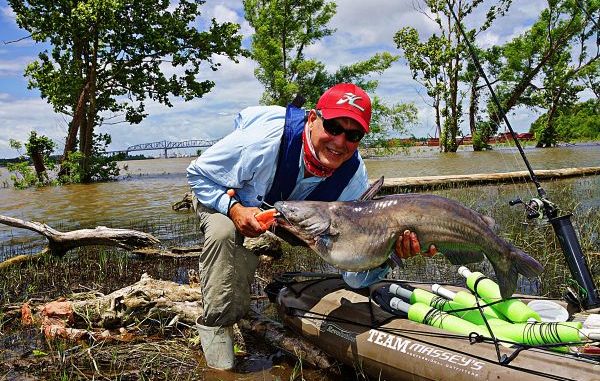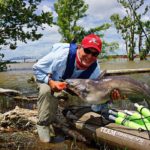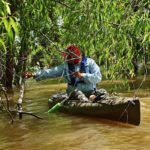
Targeting Mississippi River catfish from a kayak
Gaze over the mighty Mississippi River in southern Louisiana and you’ll see a parade of tugs and barges, work boats, ocean-going cargo ships and the weekly cruise ships.
Although not a generally hospitable environment for a kayaker, the high river offers up a unique opportunity for kayak fishermen to find some huge catfish. The vast areas of flooded batture can safely be accessed by paddle craft with proper planning and care.
First and foremost is safety. A PFD should be worn at all times. The river is certainly nothing to play with, and you should never enter the river outside of the protected batture; the swift current will sweep you downstream, and you can easily get pushed against the trees and swamped.
The idea is to stay in the flooded backwater areas where the timber lowers the effects of wakes from giant vessels on the river and also slows the river’s current.
Catfish infiltrate these flooded areas that are easy to access with a kayak.
It might take a while to find the perfect area of the river that can be safely accessed by ’yak. Since driving a vehicle on the levee is strictly prohibited, the best option is to ride down the river road and look for heavily timbered areas showing over the top of the levee. Using a satellite map Web site like Google Earth will also give you a bird’s-eye view of particular locations.
Park and walk up the levee to take a first-hand look. Parking anywhere on or at the base of the levee is prohibited.
The ideal location will be where you can see a noticeable difference in the speed of the current in the river itself versus that of the flooded batture. Due to turns in the river, thick woods or moored vessels, there are areas where the current is noticeably slower.
If you see anyone fishing from the levee itself, that can be a good indicator of a prime area. Talk to them and see what they are catching. You may be able to fish nearby areas that they cannot reach. Find these spots, and you’ll likely find a catfish gold mine.
You’ll also need to find a safe and legal area to park your vehicle near the levee. Carry or drag the ’yaks up and over the levee.
The current should be moving, but manageable. If at any time you feel it is unsafe, it is best to abandon the trip. No fish is worth dying for.
It will be necessary to anchor, but due to the snags and stumps you should use a brush anchor so you don’t get hung up. A brush anchor is a spring-loaded clamp that uses teeth to grab onto limbs or small trees. Always anchor with your bow into the current, and keep a knife handy in case you have to quickly cut the anchor loose.
Make sure to put a leash on your paddle. There’s nothing worse after battling a big fish than discovering that your paddle has floated off downstream while you were otherwise occupied.
Catfish in the river can be brutes. Many are fat from eating grain that spills into the river during the process of unloading barges at the many area grain elevators. Catfish in the 20- to 40-pound range are not uncommon, and offer a mighty challenge in a kayak.
The potential is also there to hook into an even heavier fish.
A stout rod-and-reel combo and heavy braided line will help wrestle these big bottom dwellers out of the thick cover.
Rigging for catfish is fairly simple. Use either a Carolina rig or typical bottom rig, in which your hook is a few inches above the weight. The weight size is determined by the speed of the current, and anywhere from 1 to 4 ounces might be necessary to keep the bait on the bottom. Hooks are more of a personal preference, but should be a strong circle or standard J-hook style.
Catfish are not picky, but feed mostly by smell and vibration in the muddy waters of the river. Typical catfish baits can be put into three general categories: store bought, live bait and dead/cut bait. Store-bought baits include a variety of “stink” baits that usually feature a blood or cheese scent. Live baits such as crawfish, night crawlers, sunfish or minnows also work well. Dead shrimp, cut pogie or other fish, chicken livers and even simple hot dogs will readily attract hungry catfish.
Blue cats will easily take a variety of live or dead bait, whereas, Flathead or “Opelousas” catfish generally prefer live bait.
These fish get big, and several of the top 10 Louisiana record fish have come from the Mississippi River. The current state-record blue is 110.19 pounds and the No. 1 flathead is 95 pounds — both heavier than most average kayaks.
Another bonus to kayak fishing in the batture is the ability to set out a trot line or a few drop lines while you are fishing. These take up little space, and can be quickly set out before you begin to fish. Check them when you are ready to come in and, if you are lucky, you will end up with a few extra fish to add to your catch.
A small hand gaff works better than a net to get a large cat under control ’yak-side. It’s difficult to carry a net large enough to handle these fish, and if you’re near heavy brush the net will get hung up.
A stout stringer is a good way to store the fish after being caught. A stainless steel “safety-pin” stringer like spear fishermen use will hold several large catfish and keep them alive during your trip. Use the pointed tip of the stringer to push it through the fish’s lower jaw and out the mouth. This causes no damage to the gills, and the fish can live while on the stringer.
The high water in the Mississippi River this time of year opens up many new areas for kayak fishermen wanting to get in on some great catfishing action. Precautions are necessary and safety must always be top priority. However, take some time to find that prime, safe location and you will easily load the kayak with tasty catfish.


